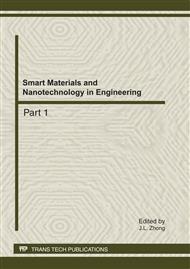[1]
M. Jain, et al, Effect of Hippophae rhamnoides leaf extract against Dengue virus infection in human blood-derived macrophages, Phytomedicine, vol. 15, no. 10, pp.793-799, october (2008).
DOI: 10.1016/j.phymed.2008.04.017
Google Scholar
[2]
P.S. Negi, et al, Antioxidant and antibacterial activities of various seabuckthorn (Hippophae rhamnoides L. ) seed extracts, Food Chemistry, vol. 92, no. 1, pp.119-124, August (2005).
DOI: 10.1016/j.foodchem.2004.07.009
Google Scholar
[3]
T. Beveridge, L. Thomas, B. Dave Oomah and A. Smith, Sea buckthorn products: manufacture a composition, Journal of Agriculture and Food Chemistry, vol. 47, no. 9, pp.3480-3488, August (1999).
DOI: 10.1021/jf981331m
Google Scholar
[4]
M.E. Yue, T.F. Jiang and Y.P. Shi, Fast determination of flavonoids in Hippophae rhamnoides and its medicinal preparation by capillary zone electrophoresis using dimethyl-cyclodextrin as modifier, Talanta, vol. 62, no. 4, pp.695-699, March (2004).
DOI: 10.1016/j.talanta.2003.09.024
Google Scholar
[5]
R.M. Facino, et al, Diet enriched with procyanidins enhances antioxidant activity and reduces myocardial post-ischaemic damage in rats, Life Sci, vol. 64, no. 8, p.627–642, January (1999).
DOI: 10.1016/s0024-3205(98)00605-5
Google Scholar
[6]
X.Y. Su, Z. Y. Wang, and J.R. Liu, In vitro and in vivo antioxidant activity of Pinus koraiensis seed extract containing phenolic compounds, Food Chemistry, vol. 117, no. 4, p.681–686, December (2009).
DOI: 10.1016/j.foodchem.2009.04.076
Google Scholar
[7]
X. Gao, et al, Changes in antioxidant effects and their relationship to phytonutrients in fruits of sea buckthorn (Hippophae rhamnoides. L) during maturation, Journal of Agricultural and Food Chemistry, vol. 48, no. 5, p.1485–1490, April (2000).
DOI: 10.1021/jf991072g
Google Scholar
[8]
L. Ganju, et al, Anti-inflammatory activity of seabuckthorn (Hippophae rhamnoides L. ) leaves, Int. Immunopharmacol, vol. 5, no. 12, p.1675–1684, November (2005).
DOI: 10.1016/j.intimp.2005.03.017
Google Scholar
[9]
S. Geetha, et al, Anti-oxidant and immunomodulatory properties of seabuckthorn (Hippophae rhamnoides)—an in vitro study, Journal of Ethnopharmacology, vol 79, no. 3, p.373–378, March (2002).
DOI: 10.1016/s0378-8741(01)00406-8
Google Scholar
[10]
J. Y. Cheng, et al, Inhibitory effects of total flavones of Hippophae Rhamnoides L on thrombosis in mouse femoral artery and in vitro platelet aggregation, Life Sciences vol 72, no. 20, p.2263–2271, April (2003).
DOI: 10.1016/s0024-3205(03)00114-0
Google Scholar
[11]
S. Ercisli, E. Orhan, O. Ozdemir and M. Sengul, The genotypic effects on the chemical composition and antioxidant activity of sea buckthorn berries grown in Turkey, Scientia Horticulturae, vol 115, no. 1, p.27–33, December (2007).
DOI: 10.1016/j.scienta.2007.07.004
Google Scholar
[12]
V. B. Guliyev, M. Gul and A. Yildirim, Review Hippophae rhamnoides L. chromatographic methods to determine chemical composition, use in traditional medicine and pharmacological effects, Journal of Chromatography, vol 812, no. 1, p.291–307, December (2004).
DOI: 10.1016/s1570-0232(04)00720-2
Google Scholar


